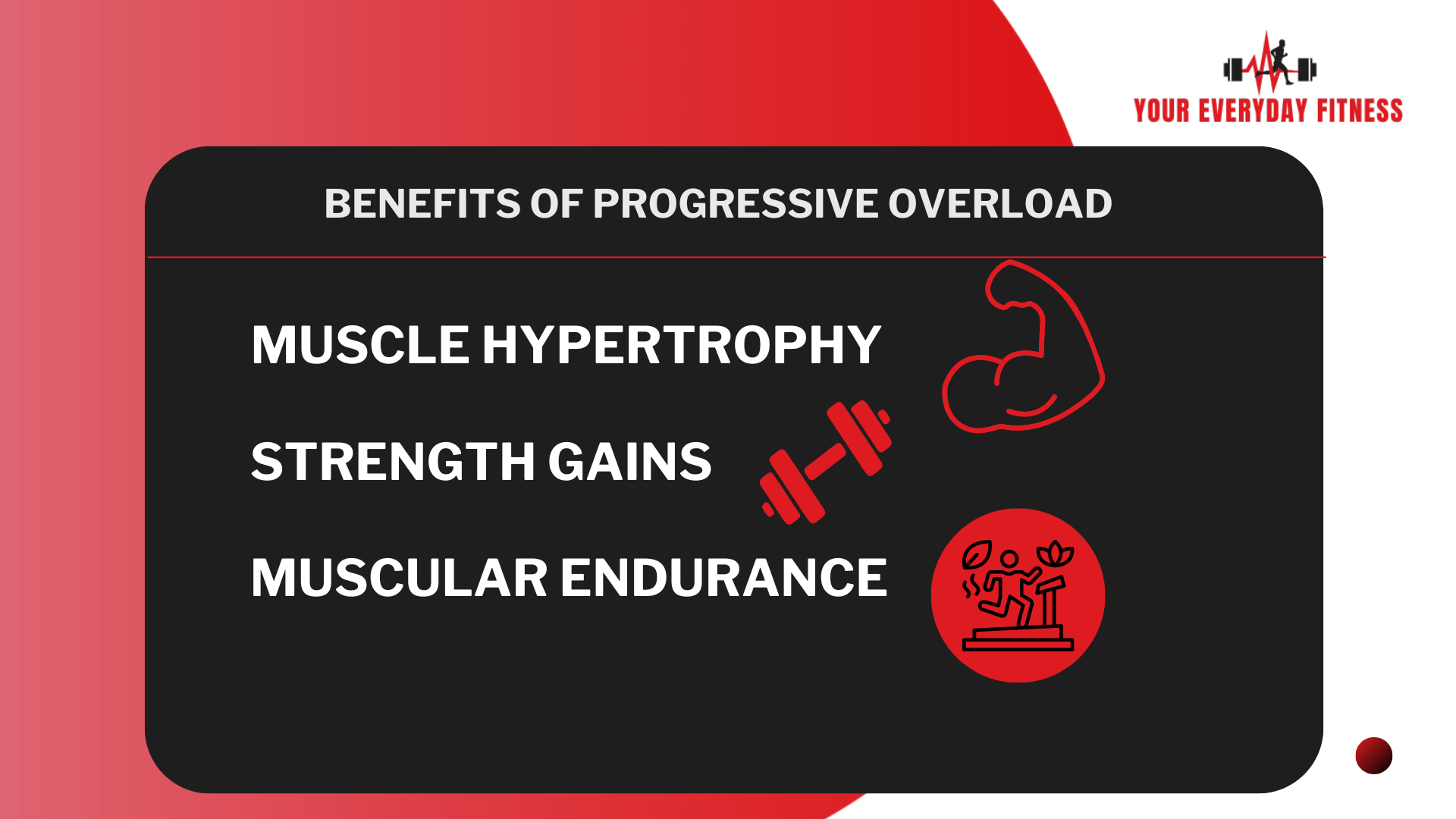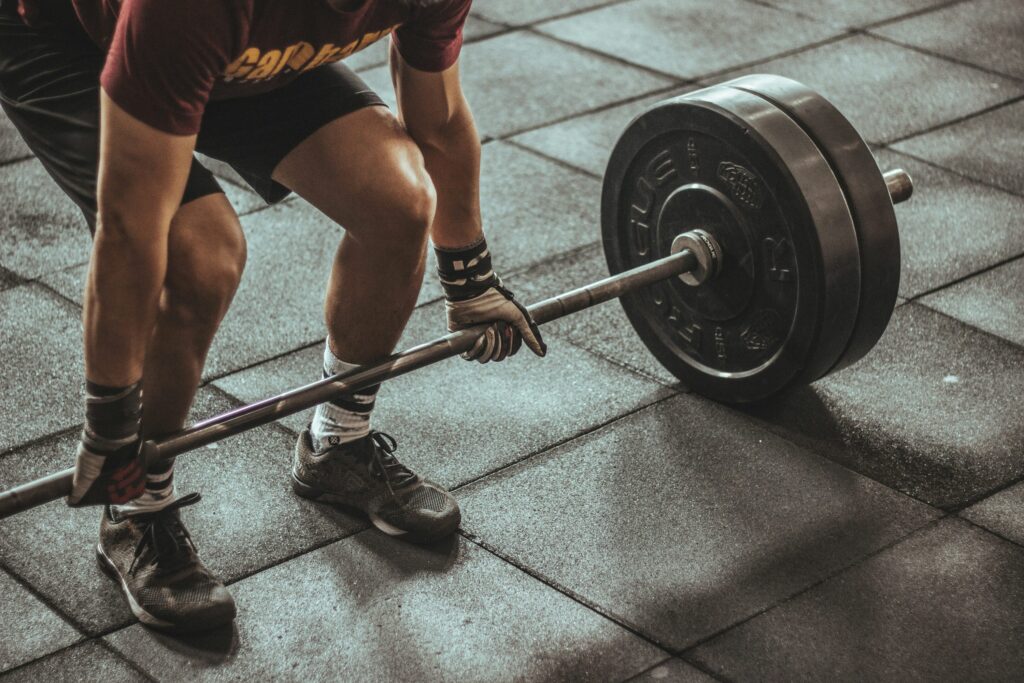If you’re looking to continuously gain muscle and strength without hitting plateaus, your best strategy is to apply progressive overload. By slowly increasing the strain on your muscles, this method guarantees muscle growth and adaptation.
Today, we will get into the process of how you can implement progressive overload effectively to help you achieve your exercise goals.
Key Takeaways
- Progressive overload is essential for continuous muscle growth and strength gains, achieved through gradual increases in load, repetitions, or volume during resistance training.
- Key methods to implement progressive overload include increasing resistance, adding more sets or repetitions, and adjusting tempo and rest periods to keep workouts challenging.
- Avoid common mistakes such as ego lifting, neglecting recovery, and lack of variation in workouts to maximize progress and prevent injuries in your training regimen.
Understanding Progressive Overload

Progressive overload refers to the gradual increase in stress placed on the body during resistance training to match its adaptive capacity. This principle is fundamental for anyone looking to enhance their physical performance through strength training.
Progressively increasing demands on your muscles makes sure your muscles continuously grow and adapt, preventing plateaus and maximizing efforts.
Without progressive overload, your body may adapt to the current level of stress, leading to stagnation in muscle development and strength gains.
Applying progressive overload is crucial for achieving fitness goals, whether lifting weights, performing bodyweight exercises, or engaging in any form of resistance training.
Understanding and implementing this principle helps create a more effective and efficient training plan, making sure every workout will help make progress in the gym.
Ways to Implement Progressive Overload
Understanding the essential elements of progressive overload is crucial for effective application. The principles of a well-structured progressive overload workout plan include steady enhancements in weight, increments in repetitions, and amplification of volume.
Concentrating on these concepts allows you to build an all-encompassing training program built to foster muscle growth (hypertrophy) along with adaptations that contribute to increasing muscular strength.
Increase in Weight

Gradually elevating the weight during your training sessions is a fundamental part of progressive overload. By constantly providing new challenges to your muscles, you foster both muscle growth and strength development. Load progression has shown to be the best type of overload for strength gains (Plotkin et al., 2022).
Individuals with some lifting experience should aim to increase their weights by modest amounts, typically in the realm of 3-5% per week. This cautious approach helps avert injuries and allows the body to accommodate itself incrementally to higher levels of demand without sacrificing technique or execution.
Concentrate on progressively adding weight so that executing those final repetitions remains challenging but is achievable during every set.
Example:
- Workout 1: Bench Press – 3 sets of 135 lbs
- Workout 2: Bench Press – 3 sets of 140 lbs
- Workout 3: Bench Press – 3 sets of 145 lbs
Increase in Repetitions

Progressive overload training can be effectively done through repetition progression. By increasing the amount of repetitions for a given exercise, you place higher demands on your muscles which contributes to their growth and strength over time. Repetition progression has shown to be better for muscle growth than load progression (Plotkin et al., 2022).
When an exercise becomes manageable, it’s beneficial to add more repetitions incrementally every few weeks. For instance, going from performing 2 sets of 10 reps to completing either 2 sets of 12 reps or advancing up to doing 3 sets.
Another technique in enhancing muscle endurance within progressive overload is by incorporating AMRAP (As Many Reps As Possible) sessions into your routine. This strategy compels you to complete the maximum possible number of repetitions within a designated time and fosters both endurance and strength-based physiological adaptations in your muscles.
Super Sets are a great method to add reps and intensify workouts. This consists of doing two or more exercises consecutively with no intervening rest periods. Typical pairings for muscle groups in Super Sets include biceps with triceps, chest paired with back, as well as quads coupled with hamstrings.
Example:
- Workout 1: Bench Press – 3 sets of 8 reps @135 lbs
- Workout 2: Bench Press – 3 sets of 10 reps @135 lbs
- Workout 3: Bench Press – 3 sets of 12 reps @135 lbs
Increase in Overall Volume

Increasing total training volume, by altering the mix of sets, reps, and weight lifted, is another way to promote muscle growth and improve performance.
Increasing volume means you could increase the amount of sets and reps, but you also could just increase the frequency of a workout. For example, you could start exercising your chest muscles twice a week, compared to only once. High volume workouts have shown to improve muscle hypertrophy compared to low volume alternatives.
Example:
- Week 1: 3 Chest Exercises per week
- Week 2: 4 Chest Exercises per week
- Week 3: 5 Chest Exercises per week
Adjusting Tempo and Decreasing Rest Periods
Changing the pace and recovery intervals during your workout routine can greatly affect how your muscles are activated and developed.
By slowing down exercise movements, you prolong the time your muscles are under tension (TUT), a key part of promoting muscle hypertrophy. This technique means you have to do exercises at a deliberate speed to maintain muscle engagement over extended periods of time.
Another way to implement progressive overload is by reducing the amount of time you take during your rest intervals. This will not allow your muscles to adapt, and it will challenge them in new ways that helps them grow.
That being said, you still need to make sure your rest intervals are long enough for proper recovery to get the best possible workout in.
If rest times are too short, it could slow down progress in building strength. Striking a balance between hard training sessions and proper recovery time is important, so make sure to listen to your body and do what suits you best.
Example:
- Week 1: 2 min rest intervals
- Week 2: 1.5 min rest intervals
- Week 3: 1 min rest intervals
Benefits of Progressive Overload

The benefits of progressive overload are extensive, making it a critical part of any effective training regimen. Workouts will become easier, and you will gain strength and size in your muscles. This not only helps prevent training plateaus, but also boosts self-confidence, providing psychological benefits alongside physical gains.
As you progressively increase the difficulty of your workouts, you’ll notice that previously challenging lifts become easier, showing the effectiveness of progressive overload.
Regular assessments and adjustments will help make sure that you’re applying the progressive overload principle effectively.
Muscle Hypertrophy
The constant practice of progressive overload is essential for substantial muscle growth. Incremental increases in the stress imposed on your muscles leads to significant muscle hypertrophy. This is because changing things up doesn’t allow your muscles to adapt, so they are properly challenged and broken down each workout, which leads to growth.
Research, including a study by Plotkin et al. (2022), has revealed that both methods of increasing load and adding repetitions result in improved levels of hypertrophy.
Evidence suggests that an increase in volume load is particularly beneficial for promoting muscle growth among females, as seen from Peterson’s 2011 findings. So you’ll need to customize your training routine according to personal objectives and requirements to optimize gains in both muscle mass and hypertrophy.
Strength Gains

Progressive overload training is instrumental in enhancing strength. Incrementally increasing the workload on your muscles results in a gradual increase in strength capacity.
Progressive overload has proven to increase one-repetition maximum (1RM) strength, with research illustrating large improvements as resistance levels increase.
To maximize gains in strength from progressive overload, it is important to do rep ranges between 1 and 6 repetitions and conduct 3 to 6 sets per exercise session.
Following this lower rep strategy guarantees that your muscle groups are being sufficiently strained, helping build the most strength.
Enhanced Muscular Endurance
Progressive overload training also leads to improved muscular endurance. By steadily increasing the number of repetitions, you can significantly enhance your muscles’ ability to endure and perform.
Yet, it is important to maintain a balance between applying enough training stress (overload) and providing sufficient recovery time. Doing so helps avoid overtraining, which could otherwise lead to lackluster performances in the gym and even injury.
Doing different types of exercises while making sure to get proper rest periods is crucial in achieving continuous growth in muscular endurance through training.
Periodization and Programming for Progressive Overload

Periodization is just a fancy way of saying that you change up your workout routine over time. It breaks down your workout plan into different phases, each focusing on specific goals like building muscle or increasing strength
This approach helps you keep improving without hitting a wall and plateauing.
Customize Your Workouts
It’s important to adjust your workouts to fit your own experience level. This helps you get stronger or build muscle more effectively.
Tailoring your routine means you can safely push your limits and see better results.
Plan Your Year
Think of your workout year as split into different chunks, each with a specific focus. One chunk might be about building muscle (hypertrophy), another about boosting your strength.
This setup helps you go about your workout routine systematically, helping you make sure you keep making gains.
Keep It Fresh
To avoid getting stuck or feeling like your workouts are getting too easy, it’s important to shake things up. As you get stronger, you need to find new ways to challenge your muscles, like lifting heavier weights or changing your exercises.
By understanding your own fitness journey and gradually upping your workout game, you’ll continuously improveme and keep your gym time effective and rewarding.
Example Periodization Schedule

Common Mistakes to Avoid

Avoiding common mistakes in your training routine is crucial to get the best results and stay injury-free. Here are a few slip-ups to watch out for:
Ego Lifting
Lifting too much weight just to show off can really set you back. It often leads to poor form, which increases your chance of injury and slows down your progress.
It’s important to increase weights slowly and safely to keep improving without risk. Trust me, I have wanted to try to throw around some heavy weight to feel cool before, but it is never the move.
Neglecting Recovery
Skipping recovery time is another big no-no. Your muscles need time to heal and grow after workouts.
If you don’t rest enough, you will feel worn out, perform poorly, and even risk overtraining.
Make sure to take a day or two off after intense sessions. On these days, light activities like yoga or a nice walk can help you recover without overdoing it.
Lack of Variation
Doing the same exercises all the time can lead to plateaus and overuse injuries. To keep things fresh and your muscles challenged, mix up your routine regularly.
This not only helps you avoid boredom but also makes sure all your muscle groups are being worked on, which is great for overall fitness and growth.
Sample Progressive Overload Workout Plans

Here’s how to structure your training as you progress from a beginner to an advanced lifter, focusing on technique, intensity, and variety:
Beginner Routine
- Focus on Technique: Start with lighter weights to master the proper form.
- Standard Exercises: Perform 3 sets of 10-12 reps of compound lifts like squats and bench presses. Increase the weight gradually as you become more comfortable.
- Add Variety: Incorporate pull-ups, single-arm rows, and goblet squats to build strength and coordination. Ensure each set is challenging but doable.
- Progression: Every few weeks, aim to increase the weight or the number of reps to continuously challenge your body.
Intermediate Routine
- Advanced Movements: Start adding more complex exercises and heavier weights.
- Intensity Techniques: Use AMRAP (As Many Reps As Possible) and EMOM (Every Minute On the Minute) workouts to push your limits.
- Example: Try 10-12 push presses at the start of every minute for 5 minutes.
- Incorporate HIIT: High-Intensity Interval Training is great for boosting strength and muscle endurance, maximizing your training efficiency.
Advanced Routine
- Keep Pushing: Focus on sustaining muscle growth with challenging techniques.
- Intensity Boosters: Employ drop sets and supersets to increase muscle strain and fatigue, fostering further growth.
- Mix Methods: Combine various strategies like drop sets with supersets to enhance workout intensity.
- Avoid Plateaus: Constantly vary your approach to training to prevent stagnation and ensure continuous improvement.
Monitoring Progress and Making Adjustments

Keeping a close eye on your training progress is key for effective progressive overload training. Here’s a simple way to make sure you’re on the right track:
Tracking Workouts
A workout log isn’t just a diary—it’s a tool that helps you apply progressive overload correctly. Writing down what you do in each session lets you see what works, what doesn’t, and how you can keep getting better.
I have a strength and conditioning journal that I use to track all my workouts, and it has made a world of difference for me. I have every workout written down from the last 5 years, and it is amazing to look back on from time to time. I could not recommend this enough.
Using RPE and RIR Scales
To manage how hard you push yourself, use tools like the RPE (Rate of Perceived Exertion) and RIR (Reps In Reserve) scales. RPE measures how hard a workout feels on a scale from 1 to 10, while RIR estimates how many reps you have left in the tank before you can’t do any more.
These tools help you adjust your training intensity wisely—helping you challenge yourself without risking overtraining.
Regular Assessments

Regularly assessing your progress is vital. It lets you know if your current approach is working and helps you apply the principles of progressive overload effectively.
By regularly checking in on your performance, you can make well-informed adjustments to your routine, so that you continuously progress towards your fitness goals.
By tracking your workouts, using RPE and RIR, and assessing your progress regularly, you’ll be on your way to a more effective training routine.
Summary
Figuring out the art of progressive overload has been a game-changer for me, helping me continuously grow in both muscle size and strength. By gradually increasing the weights, reps, or even the total volume of my workouts, I’ve been able to make a workout plan that really pushes my growth in the gym to new levels.
I’ve learned it’s crucial to sidestep some easy traps, like letting my ego dictate the weights I lift (we’ve all been there), skipping out on rest days, or getting stuck in a routine rut. These mistakes can really throw a wrench in your progress.
Sticking to a solid plan and keeping a close eye on my achievements has made all the difference. By staying disciplined and focused, I keep improving step by step, and so can you. If you keep at it and track your progress, you’ll not only meet your fitness goals—you’ll smash them. Time for you to take this amazing principle into the gym and grow more than you ever knew possible.
Sources:
- Plotkin D, Coleman M, Van Every D, Maldonado J, Oberlin D, Israetel M, Feather J, Alto A, Vigotsky AD, Schoenfeld BJ. Progressive overload without progressing load? The effects of load or repetition progression on muscular adaptations. PeerJ. 2022 Sep 30;10:e14142. doi: 10.7717/peerj.14142. PMID: 36199287; PMCID: PMC9528903.
- Peterson MD, Pistilli E, Haff GG, Hoffman EP, Gordon PM. Progression of volume load and muscular adaptation during resistance exercise. Eur J Appl Physiol. 2011 Jun;111(6):1063-71. doi: 10.1007/s00421-010-1735-9. Epub 2010 Nov 27. PMID: 21113614; PMCID: PMC4215195.
- Geanta, V. A., & Ardelean, V. P. (2021). Improving muscle size with Weider’s principle of progressive overload in non-performance athletes. Timisoara Physical Education and Rehabilitation Journal, 14(27), 27-32. DOI: 10.2478/tperj-2021-0011.
-
Schoenfeld BJ, Contreras B, Krieger J, Grgic J, Delcastillo K, Belliard R, Alto A. Resistance Training Volume Enhances Muscle Hypertrophy but Not Strength in Trained Men. Med Sci Sports Exerc. 2019 Jan;51(1):94-103. doi: 10.1249/MSS.0000000000001764. PMID: 30153194; PMCID: PMC6303131.







